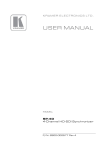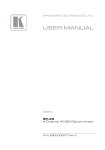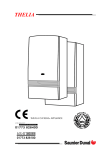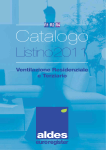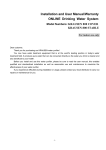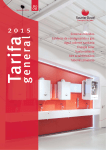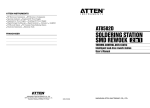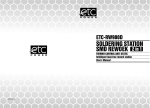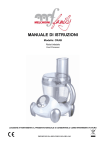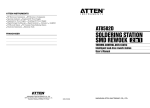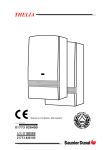Download Saunier Duval Thelia 30 E Operating instructions
Transcript
THELIA 30 E IN WARRANTY TECHNICAL HELPLINE 01773 828400 01773 828100 THIS IS A CAT II 2H3 APPLIANCE 1 INSTALLATION AND OPERATING INSTRUCTIONS THELIA 30 E Note! The boiler serial number is marked on the label attached to the top of the inner bulkhead. Refer to the 'Introduction' section page 3 for a description of the basic functions of the boiler. The 'Users' section describes how to safely operate the boiler. USERS SECTION Introduction .................................................... Page 3 Commissioning ......................................................... 3 Controls & lighting .................................................... 4 Draining ..................................................................... 4 Servicing/maintenance .......................................... 4 INSTALLATION SECTION Introduction .................................................. Page 3 Dimensions ............................................................. 5 Boiler schematic .................................................... 5 Technical data ...................................................... 6 Boiler connections ................................................. 7 Piping system installation ...................................... 7 Boiler location ........................................................ 8 Heating system design ......................................... 9 Domestic hot water system design ..................... 9 Boiler installation .................................................... 9 Flue installation ............................................. 10 - 11 Electrical installation ........................................... 12 Commissioning ............................................. 13 - 14 Operating safety devices .................................. 14 Settings .................................................................. 15 Changing gas type ............................................. 15 Mandatory warning for CEE countries Warning: This appliance was designed, approved and inspected to meet the requirements of the English market. The identification plate located on the inside of the appliance certifies the origin where the product was manufactured and the country for which it is intended. If you see any exception to this rule, please contact your nearest Saunier Duval dealer. Thank you in advance for your assistance. 2 INTRODUCTION The THELIA 30 E boiler is a wall mounted combination boiler providing central heating and instantaneous hot water. The boiler is of the II 2H3 category for use with Natural Gas (G20) as distributed in the United Kingdom, or Butane (G30), Propane (G31) or Towns gas (G130). Boilers burning LPG or similar gases MUST NOT be fitted in basements or below ground level. Domestic hot water demand always has priority over heating demand. The boiler is designed for use as part of a sealed water central heating system with fully pumped circulation. The pump, expansion vessel and associated safety devices are all fitted within the boiler. The boiler can be installed against either an external wall or on an adjacent inside wall, that is, the flue system will pass directly to the rear or to either side to the terminal fitted on the outside wall face. The boiler has a fan assisted balanced flue which both discharges the products of combustion to and draws the combustion air from the outside of the room. The boiler is suitable for top outlet flue connection only but, can be fitted with horizontal flue, vertical flue or twin-pipe flue. Refer to flue catalogue for further details. The installation must be carried out by a competent person in accordance with the relevant requirements of The Building Regulations, The Water Byelaws, The Building Standards (Scotland) Regulations and any applicable local regulations. Both the central heating and domestic hot water temperature are user adjustable from the boiler control panel. Ancillary equipment A range of flue accessories are available including vertical flues, twin-pipe flues, bends etc. For further information contact your supplier. These instructions should be carefully followed for the safe and economical use of your boiler. COMMISSIONING Gas safety (Installation and Use) Regulations In your interests and that of gas safety, it is the law that ALL gas appliances are installed and serviced by a competent person in accordance with the above regulations. Boiler controls The control panel, located at the lower front of the boiler casing, see diagram 1, allows the boiler to be started, shut down, controlled and monitored during use. Gas leak or fault If a gas leak or fault exists or is suspected, turn the boiler off and consult the local gas supply company or your installation/service company. Flue Do not obstruct the outside terminal of the boiler. A B C D E F A B - Pressure gauge Temperature gauge Reset button N/A on this model Mains 'ON' warning light Loss of water warning light C D E G H I J K L F G H - N/A on this model Safety shutdown warning light Domestic hot water temperature control Heating temperature control 'Summer/winter' selector N/A on this model I J K L bar 0 Hab 031a Diagram 1 3 CONTROLS AND LIGHTING Starting the boiler Before starting the boiler check that: • The gas meter tap is open. • The boiler gas service cock is open. • The boiler is connected to the electrical supply and turned on. Setting to SUMMER mode (Hot water only) • Turn the OFF/Summer/Winter' switch (K) to the 'Summer' position, see diagram 1. • Turn the domestic hot water temperature control (I) to the desired setting, see diagram 1. To obtain domestic hot water, open a hot water tap. Hot water always has priority over central heating. Setting to WINTER mode (Heating and hot water) • Turn the OFF/Summer/Winter selector switch to (K) to the 'Winter' position, see diagram 1. • Turn the central heating temperature control (J) to the desired setting, see diagram 1. • Turn the domestic hot water temperature control (I) to the desired setting, see diagram 1. • Make sure that any external controls are calling for heat. The heating system will begin to heat up. To obtain domestic hot water, open a hot water tap. Hot water always has priority over central heating. DRAINING Protection against freezing If the boiler is to be out of use for any long periods during severe weather conditions, it is recommended that the whole system, including the boiler, be drained to avoid the risk of freezing. If in doubt, consult your servicing company. The THELIA 30 E boiler has a built in frost protection device that protects the boiler from freezing. If the boiler is to be left and there is a risk of frost, ensure that the gas and electrical supplies are left connected and that the OFF/Summer/Winter switch is left in the'Summer' or 'Winter' position.The frost protection device will light the boiler when the temperature of the boiler water falls below 6°C. When the temperature reaches 16°C, the boiler stops. Note: This device works irrespective of any room thermostat setting and only protects the boiler. Always ensure that adequate frost protection is given to the entire system where necessary. Draining and filling Caution: The boiler is installed as part of a sealed system which must only be drained and filled by a competent person. Heating safety valve CAUTION: A safety valve with a discharge pipe is fitted to this boiler. The valve MUST NOT BE TOUCHED except by a competent person. If the valve discharges at any time, switch the boiler off and isolate it from the electrical supply. Contact your installation/service company. SERVICING/MAINTENANCE To ensure the continued efficient and safe operation of the boiler, it is recommended that it is checked and serviced at regular intervals. The frequency of servicing will depend upon the installation conditions and usage but, in general, once a year should be enough. Cleaning The boiler casing can be cleaned with a damp cloth followed by a dry cloth to polish. Do not use abrasive or solvent cleaners. 4 Boiler casing CAUTION. Do not remove or adjust the casing in any way, as incorrect fitting may result in faulty operation. If in DIMENSIONS Diagram 2 260 80 217 Ø 100 The boiler is delivered in three separate packages: - The boiler itself - The fixing jig - The flue system For flue systems greater than 1 m long, remove the cup restrictor from the boiler flue outlet. 889 between 0,5 and 1,5 m fit diaphragm (a) seal a - diaphragm Net weight : Gross weight : Hab 036 520 393 55 kg 57 kg BOILER SCHEMATIC Diagram 3 15 A B C D E - - Bypass Loss of water pressure switch Pump Automatic air vent Expansion vessel Injector manifold Ignition electrode Expansion vessel filling valve Overheat thermostat Heat exchanger Fan Air pressure switch Automatic air vent Flame sense electrode Thermostatic valve 3-way valve Gas valve Water valve Safety valve (3 bar) Domestic hot water expansion vessel Heating return Cold water inlet Heating flow Domestic hot water flow Gas supply 14 16 13 12 11 17 18 10 9 8 20 19 21 7 6 5 4 3 2 22 23 24 25 1 Shy 025 1 2 3 4 5 6 7 8 9 10 11 12 13 14 15 16 17 18 19 20 5 TECHNICAL DATA Heating output adjustable from 12,7 kW to 30,2 kW Hot water outputauto. variable from 12,7 kW to 30,2 kW 43330 Btu/H to 103,040 Btu/H Efficiency 81 % 90 °C Maximum heating temperature Expansion vessel effective capacity 10 l Expansion vessel charge pressure 1,0 bar Maximum system capacity at 75°C 190 l Safety valve, maximum service pressure 43330 Btu/H to 103,040 Btu/H 65 °C Maximum hot water temperature Specific flow rate (for 30°C temperature rise) 14,5 l/min Maximum supply pressure 7 bar Maximum domestic hot water flow 12 l/min Expansion vessel effective capacity 0,5 l 3 bar Products outlet 60 mm Fresh air inlet 100 mm Electrical supply 230 V Maximum absorbed power 165 W Natural Nas Butane Propane (G20) G(30) G(31) Burner injector 1,2 mm 0,75 mm 0,75 mm Inlet pressure 20 mbar 28 mbar 37 mbar 2,6 - 12,0 mbar 5,4 - 25,5 mbar 7,2 - 34,6 mbar Gas rate (maximum) 3,54 m3/h 2,64 kg/h 2,6 kg/h Gas rate (minimum) 1,56 m3/h 1,16 kg/h 1,15 kg/h Burner pressure By-pass open 50 40 30 20 By-pass closed 10 Pom 011 Available pressure (kPa) between heating supply and return lines Pump : Diagram 4 500 0 pressure (mbar) (10 kPa = 1 m WG) 1000 1500 Flow rate through heating system (I/h) Burner setting pressures Propane (G 31) 35,0 Butane (G30) 30,0 Natural gas (G 20) 25,0 20,0 15,0 5,0 Heat output (kW) 6 30,2 28 26 24 22 20 18 16 14 0,0 12,7 Burner 10,0 BOILER CONNECTIONS From left to right the fixing jig comprises : A - Heating return with isolating valve (m). B - Cold water inlet with isolating valve (p). C - Heating flow with isolating valve (q), drain screw (r) and safety valve (s). D - Domestic hot water outlet. E - Electrical connection box. F - Gas supply. Diagram 5 5 5 Filters and washers: 1 - Fibre washer 2 - Metal filter 3 - Plastic filter 4, 5 and 6 -Black graphite 23 3 5 5 11 ,5 7 5 34 25 2 ,5 7 5 33 m 1 p 3 A r 4 B q s 5 C 6 D Pla 041 F E PIPING SYSTEM INSTALLATION • • • • Heating system connections - Pipe diam 22 mm Hot water system connections - Pipe diam 15 mm Gas connection - Pipe diam 22 mm Safety valve discharge - Pipe diam 15 mm Water connection Connect the copper tails and isolating cocks supplied, to the boiler, see diagram 5. Connect the system pipework to the boiler observing the correct flow and return format as shown in diagram 5. Safety valve discharge WARNING. It must not discharge above an entrance or window or any type of public access area. Connect the safety valve discharge pipe to the boiler, the discharge must be extended using not less than 15 m o.d. pipe, to discharge in a visible position outside the building, facing downward preferably over a drain. The pipe must have a continuous fall and be routed to a position so that any discharge of water, possibly boiling or steam, cannot create any danger to persons, damage to property or external electrical components and wiring. Tighten all pipe connection joints. Connect the safety valve discharge pipe to the boiler, the discharge must be extended using not less than 15 m o.d. pipe, to discharge in a visible position outside the building, facing downward preferably over a drain. The pipe must have a continuous fall and be routed to a position so that any discharge of water, possibly boiling or steam, cannot create any danger to persons, damage to property or external electrical components and wiring. Tighten all pipe connection joints. Gas connection • The supply from the governed gas meter must be of adequate size to provide a constant inlet working pressure of 20 mbar (8 in w.g.). To avoid low gas pressure problems, it is recommended that the gas supply is connected using 22 mm pipe. • On completion, the gas installation must be tested using the pressure drop method and purged in accordance with the current issue of BS6891. Gas Safety (Installation and Use) Regulations In your interests and that of gas safety, it is the law that ALL gas appliances are installed and serviced by a competent person in accordance with the above regulations. 7 BOILER LOCATION Clearances The position of the boiler must be such that there is adequate space for servicing. The recommended clearances are: 40 mm either side of the boiler. 600 mm at the front of the boiler. 300 mm below the boiler. 300 mm above the boiler. Diagram 7 59 Ins 005a Terminal position The minimum acceptable spacings from the terminal to obstructions and ventilation openings are shown in diagram 8. The boiler must be installed so that the terminal is exposed to the external air. Should any doubt exist as to the permissible position of the terminal, contact the Saunier Duval Technical Helpline 01773 828400. • Mark the position of the holes for the hook and connecting plate. • Drill, plug and fix the connecting plate and hook to the wall using suitable screws. • Check that both the hook and connecting plate are level. - 889 63 If the boiler is not installed immediately, protect the various couplings to prevent any ingress of foreign materials e.g. plaster, paint etc. • Place template on wall in required position, making allowances for the necessary clearances etc. Note: It is permissible to install the boiler with reduced clearances at the bottom and sides of the boiler PROVIDING that adequate consideration is given for Servicing/Repairs at a later date. If any doubt exists, contact the Saunier Duval Technical Helpline 01773 828400. A B C D E F G 135 767 135 Fixing jig The fixing jig comprises three parts: 1) The connecting plate which allows the connection and soundness testing of all the pipework before the boiler is fitted and helps support the weight of the boiler. 2) The hook which supports the weight of the boiler. 3) The template which ensures the hook and connecting plate are correctly fitted relative to one another. Diagram 8 520 Cupboard or compartment ventilation The boiler can be fitted in a cupboard or compartment as long as adequate permanent high and low level ventilation is provided in accordance with ventilation requirements Minimum dimensions (in mm) for the positioning of flue terminals under a window ............................................ 300 under an air vent .......................................... 300 under a gutter ................................................. 75 under a balcony ........................................... 300 from an adjacent window ........................... 300 from an adjacent air vent ........................... 300 from vertical or horizontal air pipes ............... 300 H I L M N - from an external corner of the building ..... 300 from an internal corner of the building ...... 300 from the ground or from another floor ........... 300 between two terminals vertically ............ 1500 between two terminals horizontally ........... 600 G N C E F M A D I L H Ven 060a B 8 HEATING SYSTEM DESIGN • Where thermostatic radiator valves are fitted, not all radiators must be fitted with this type of valve, and in particular, where the room thermostat is installed. • In the case of an existing installation, it is ESSENTIAL that the system is thoroughly flushed prior to installing the new boiler. Filling the system Provision must be made for filling the system at low level. The use of a WRC approved filling loop is strongly recommended, connected as shown in diagram 6. Diagram 6 Domestic water Boiler Hot Additional expansion vessel (if required) Tundish (supplied) Cold supply Pressure reducing valve (supplied) Minimum 22 mm diameter Return Bypass valve Filling point Heating circuit Flow control valve Sch 173 • The THELIA 30 E boiler is compatible with any type of installation. • Heating surfaces may consist of radiators, convectors or fan assisted convectors. • Pipe sectional areas shall be determined in accordance with normal practices, using the output/ pressure curve (diagram 4). The distribution system shall be calculated in accordance with the output requirements of the actual system, not the maximum output of the boiler. However, provision shall be made to ensure sufficient flow so that the temperature difference between the flow and return pipes be less than or equal to 20°C. The minimum flow is 500 l/h. • The piping system shall be routed so as to avoid any air pockets and facilitate permanent venting of the installation. Bleed fittings shall be provided at every high point of the system and on all radiators. • The total volume of water permitted for the heating system depends, amongst other things, on the static head in the cold condition. The expansion vessel on the boiler is pressurised at 1 bar (corresponding to a static head of 5 m w.g.) and allows a maximum system volume of 150 litres for an average temperature of 75°C and a maximum service pressure of 3 bar. This pressure setting can be modified at commissioning stage if the static head differs. An additional expansion vessel can be fitted to the system if required, see diagram 6. • Provision shall be made for a drain valve at the lowest point of the system. Drain point DOMESTIC HOT WATER SYSTEM DESIGN • Copper tubing must be used for the domestic hot water system. Unnecessary pressure losses should be avoided. • The flow restrictor must be fitted in the cold water inlet during installation. This limits the flow through the boiler to a maximum of 12 l/min. BOILER INSTALLATION Statutory requirements The installation of this boiler must be carried out by a competent person in accordance with the relevant requirements of the current issue of: The Gas Safety (Installation and Use) Regulations The Building Regulations The local water company Byelaws The Building Standards Regulations (Scotland) The Health and Safety at Work Act Sheet metal parts WARNING. When installing or servicing this boiler, care should be taken when handling the edges of sheet metal parts to avoid the possibility of personal injury. Installing the boiler Prior to starting work, the system must be thoroughly flushed so as to eliminate any foreign bodies and contaminants such as filings, solder particles, oil, grease etc. Note. Solvent products could cause damage to the system. • Engage boiler upper part onto the hanging bracket. • Allow the boiler to seat down onto support plate. • Fit filter and washers, strictly adhering to the sequential order and directions shown on diagram 5. • Connect the various couplings between boiler and connection plate. 9 FLUE INSTALLATION The boiler is only suitable for top outlet flue connection. A - Flue to rear of boiler • Mark correct position of hole from template. Diagram 9 ∆L2 ∆L1 B - Flue to side of boiler • Mark the horizontal centre line for the hole on the rear wall. Extend the horizontal centre line to the side wall and mark the vertical centre line of flue hole as shown in diagram 9. ∆L2 ∆L1 Under normal circumstances, it will be possible to gain access to the outside of the building to fit the flue terminal assembly. Where outside access is not possible e.g. high rise buildings, the flue terminal can be fitted from inside the building only if required. Cutting the flue hole • Making allowance for the slope of the flue, cut hole in external wall, preferably using a core drill. For installations with internal and external access Use a 105 mm diameter core drill. For installations with internal access only - Use a 125 mm diameter core drill. Important: Before cutting the hole for flues to the rear of boiler, always cover fixing jig to make sure it is not damaged. Calculation of flue cutting lengths • Measure wall thickness e (mm), see diagram 9. • For side flues, measure distance from inside face of side wall to centre line of flue and subtract 260 mm for right and left hand flue to get dimension a (mm). • Refer to table 1 for cutting lengths of both inner and outer flue pipes for each of the various flue options available. Important: All flue cutting lengths must be measured from the terminal end of the flue pipes, see diagram 10. When the dimension X measured on site is greater than that given in table 1, a flue extension kit will be required, refer to table 2 for details. e a e a X X Diagram 10 Outer pipe Cutting length Terminal end Inner pipe Cutting length Ven 089 Important: When cutting the flue hole and when extending the flue centre line to a side wall, remember that the flue system must have a fall of about 35 mm per metre of flue DOWNWARD AWAY FROM the boiler. There must NEVER be a downward incline towards the boiler. Table 1 Flue option Rear flue Cutting length (mm) outer pipe inner pipe e + 145 e + 228 Comments maximum wall thickness "e" without extension 522 mm Side flue left e + a + 188 e + a + 271 maximum distance "X" without extension 739 mm Side flue right e + a + 188 e + a + 271 maximum distance "X" without extension 739 mm Table 2 10 Flue option Dimension "X" N° of extension kits Side flue left or right 522 to 1478 mm 1479 to 2479 mm 1 2 FLUE INSTALLATION Extended flue The horizontal flue is extended by using one or more of the 1000 mm extension pipes, Saunier Duval part number 85091. These are connected together by push fit type joints, clamps and seals. Table 3 Flue option Calculation of flue cutting lengths for extended flue • Using the correct number of extension kits as table 2, measure dimensions a and e, see diagram 9. Cut both the inner and outer pipe to the dimensions given in table 3. Comments Side flue left e + a - 1479 e + a - 1479 maximum dimension "X" without extension 739 mm Side flue right e + a - 1479 e + a - 1479 maximum dimension "X" without extension 739 mm Diagram 11 Important: All cutting lengths should be measured from the push fit end of the extension pipe. Do not leave any burrs or sharp edges on the cut ends of the pipes. P O Q N R U T S V Pho 088 Installation of flue assembly • Fit rubber sealing collar (P) into groove at the outer end of pipe (N), see diagram 11. • Fit outer pipe (N) into wall with groove to the outside. • Pull pipe inwards to bring rubber sealing collar hard up against external wall, see diagram12. • Fit internal plastic flange (Q) onto outer pipe. Push along the pipe until engaged against internal wall. • From inside, insert inner pipe (O) into outer pipe. • Fit both 'O' rings (T) into the flue elbow (V), one at the inlet, one at the outlet. By necessity, they are a loose fit, apply a small amount of silicone grease to each 'O' ring when fitting. • Slacken the two screws and fit the clamp and seal (R) onto the elbow. • Take hold of the inner flue and push gently onto the elbow outlet taking care not to tear the 'O' ring. Diagram 12 Pho 087 Important: If the flue has been cut, ensure that there are no burrs that could damage the 'O' ring. • Push the elbow clamp and seal over the outer flue. • For flue systems less than 1 m long, leave the cup restrictor (a) fitted in the boiler flue outlet, see diagram 13. Cutting length (mm) outer pipe inner pipe • Remove the backing from the self adhesive gasket (S) and carefully fit gasket to base of flue elbow. • Fit spacer (b) onto underside of elbow, fit elbow onto boiler and secure with the four screws (U). Diagram 13 L Spacer b 5 Hab 243 16 18 2 80 Restrictor a 11 ELECTRICAL INSTALLATION WARNING. This boiler must be earthed. All system components shall be of an approved type. Do not interrupt the supply with a time switch or programmer. Connection of the whole electrical system and any heating system controls to the electrical supply must be through a common isolator. WARNING. ON NO ACCOUNT MUST ANY EXTERNAL VOLTAGE BE APPLIED TO ANY OF THE TERMINALS ON THE HEATING CONTROLS CONNECTION PLUG. Isolation should preferably be by a double pole switched fused spur box having a minimum contact separation of 3 mm on each pole. The fused spur box should be readily accessible and preferably adjacent to the boiler. It should be identified as to its use. Warning : This appliance must be wired in accordance with these instructions. Any fault arising from incorrect wiring cannot be put right under the terms of the Saunier Duval guarantee. Connect the integral supply lead, coiled and tucked behind the boiler, to the mains supply. Important : The integral mains supply lead is specific to the boiler. A replacement can be obtained by quoting part number 57037. A fused three pin plug and socked outlet may be used instead of the fused spur box provided that, a) They are not used in a room contaning a fixed bath or shower b) Both the plug and socket comply with the current issue of BS 1363. The mains electrical supply must be maintained at all times in order to provide correct operation of the boiler. External controls The boiler will work for heating without a room thermostat and/or timeswitch being connected provided that the wire link fitted between the top two terminals of the connector is left in place, see diagram 14. A 230V room thermostat can be used but do not make any connection to the compensating resistor, see diagram 14. ON NO ACCOUNT must any electrical voltage be applied to any of the terminals of the external controls plug. For use with a timeswitch or timeswitch and room thermostat see diagram 14. All models In case of difficulty obtaining a suitable timeclock/ room thermostat, a programmable room thermostat is available as an accessory, Saunier Duval part number 40010. Please contact your supplier. No external controls Factory fitted link Boiler connector Room thermostat only Voltage free room thermostat External controls plug Do not connect Room thermostat and time clock Time clock Diagram 14 12 External controls plug Voltage free room thermostat Do not connect EXTERNAL CONTROLS CONNECTIONS Warning: - All external controls must be voltage free - On no account must any external voltage be applied to any of the external controls plug terminals COMMISSIONING The commissioning and first firing of the boiler must only be done by a competent person. Diagram 15 Gas installation It is recommended that any air is purged from the supply at the gas inlet test point on the lower right hand side of the gas valve, see diagram 15. Filling the system • Open shut off valves, see diagram 5 (slot of screw corresponds to flow direction), and caps on automatic air vents on top of pump and top right hand side of boiler. • Bleed each radiator until a continuos jet of water is obtained. • Do not close automatic air vent caps on boiler. • Open various hot water taps to bleed system. • Make sure that pressure gauge reads between 1 and 2 bar. Re-pressurise system as necessary. Gas inlet test point First starting up • Following the instructions given in the 'Controls and Lighting' section, set boiler to run in central heating mode. • Set boiler thermostat for maximum temperature and check that any external controls, if fitted, are calling for heat. • Allow the temperature to rise to the maximum value, with all radiator valves open. The temperature rise will cause release of the gases contained in the water of central heating system. - Gases driven towards the boiler will be automatically released through the automatic air vents. - The gases trapped at the highest point of the system must be released by bleeding the radiators. On reaching maximum temperature, the boiler should be turned off and the system drained as rapidly as possible whilst still hot. • Refill system to a pressure of 1 bar and vent as before. • Restart boiler and operate until a maximum temperature is reached. Shut down boiler and vent heating system. If necessary, top up heating system and make sure that a pressure of 1 bar is indicated on the pressure gauge when system is COLD. Gas pressures The main burner pressure should be checked during commissioning to make sure the correct input is obtained. Proceed as follows: • Shut down boiler. Diagram 16 Connect the pressure gauge to MP and RMP MP = measuring point RMP = reference measuring point pressure gauge Ins 006 Starting the boiler Before starting the boiler check that: - The gas meter tap is open. - The boiler gas service cock is open. - The boiler is connected to the electrical supply. Ins 009 Important: - If this procedure is not carried out properly, the boiler will go into safety lock-out until all of the air has been purged. - When venting air from boiler, do not touch the schrader valve on the expansion vessel, it is NOT a vent. • Undo screws on burner pressure test points RMP and MP below sealed combustion chamber, see diagram 16. • Connect a suitable pressure gauge. • Gain access to the rear of the control panel and locate the range rating adjuster screw, see diagram 17. • Start boiler as described in 'Instruction for Use'. • Set OFF/Summer/Winter switch to 'Winter' (Heating and hot water ) position. 13 COMMISSIONING Note: This adjustment does not affect the domestic hot water output. If measured burner pressure differs greatly from the given figure, check the gas inlet pressure as follows: • Shut down boiler. • Remove screw from inlet test point on the side of the gas valve, see diagram 15. • Connect a suitable pressure gauge. • Start boiler as described in 'Instructions for Use'. • Check that the inlet pressure reading matches that given in 'Technical Data' for the type of gas being used. Diagram 17 Reg 014 • Set boiler thermostat to maximum and check that any external controls are calling for heat. • Check that the reading on the gauge matches that given in 'Technical Data' for the type of gas being used. • Adjust the range rating adjuster screw as necessary to obtain the desired input. • Shut down boiler. • Remove pressure gauge, tighten up test point screws and check for gas soundness. • Using a ball point pen, clearly indicate on the data label the input the boiler is set to. • Shut down boiler. • Remove pressure gauge, tighten up test point screws and check for gas soundness. • If the gas pressure is incorrect, refer to the Fault Finding section in 'Servicing Instructions'. • If the inlet pressure is below that given, the gas supply pipework/meter must be checked and any fault corrected. • In the case of an LPG installation, check the storage tank or cylinder, regulator and pipework. OPERATING SAFETY DEVICES Gas leak or fault If a gas leak or fault exists or is suspected, turn the boiler off and consult the local gas undertaking or your installation/servicing company. In case of power supply failure The boiler no longer operates. As soon as power supply is restored, the boiler will be automatically restarted. Air flow rate safety device If an obstruction, even partial, of the flue occurs, for any reason whatsoever, the built in safety system of the boiler will turn the boiler OFF and the fan will continue to run. The boiler will be ready to operate when the fault has been cleared. In case of loss of water in the system CAUTION. The boiler is installed as part of a sealed system which must only be drained and filled by a competent person. If the pressure shown on the pressure gauge is less than 1 bar or if the red loss of water warning light is ON, the system must be filled up immediately. Call your Installation/ Servicing company. 14 Important notice: A central heating system cannot operate satisfactorily unless it is properly filled with water and unless the air initially contained in the piping systems has been properly bled off. If these conditions are not satisfied, air noise will occur within the system. Air in the heating system Persistent air in the heating system may indicate leaks in the system or corrosion taking place. Call your Installation/Servicing company. Overheat safety In the event of a problem, the overheat safety devices cause safety shutdown of the boiler. If this happens, call your Installation/Servicing company. The THELIA 30 E boiler has a built in frost protection device that protects the boiler from freezing. If the boiler is to be left and there is a risk of frost, ensure that the gas and electrical supplies are left connected and that the OFF/Summer/Winter switch is left in the'Summer' or 'Winter' position.The frost protection device will light the boiler when the temperature of the boiler water falls below 6°C. When the temperature reaches 16°C, the boiler stops. Note: This device works irrespective of any room thermostat setting and only protects the boiler. Always ensure that adequate frost protection is given to the entire system where necessary. SETTINGS Gas valve setting All boilers are tested and factory set during manufacture. Should it be necessary to reset a gas valve, for example after replacement, proceed as follows: • Shut down boiler. Diagram 18 Maximum setting • Reconnect the electrical connector removed from the modulating gas valve coil. • Remove the protective cover from the gas valve adjuster. • Turn nut 'B' , see diagram 18: CLOCKWISE: To increase the pressure. ANTICLOCKWISE: To decrease the pressure. Reg 020 Minimum setting • Remove one electrical connector from the modulating gas valve coil, see diagram 18. • Connect a suitable pressure gauge as described in 'Commissioning'. • Turn the OFF/Summer/Winter switch to the 'Summer' position. • Turn the domestic hot water temperature adjuster to maximum setting. • Remove the protective cover from the gas valve adjuster. • Turn nut 'A' , see diagram 18: CLOCKWISE: To increase the pressure. ANTICLOCKWISE: To decrease the pressure. Diagram Diagram 19 19 After adjustment, refit the cover to the gas valve adjuster. ➞ Reg 046 Bypass The THELIA 30 E has a built-in bypass. This must be adjusted according to the requirements of the system, refer to the flow rate pressure curve (diagram 4). The boiler is supplied with the built-in bypass open a half a turn. It is adjusted by turning the bypass screw, see diagram 19. Turn the screw clockwise to close the bypass. When using thermostatic radiator valves (TRV's), it is recommended that an additional, adjustable bypass of 15 mm minimum diameter is fitted between the flow and return of the heating circuit, see diagram 6. Any bypass must be fitted before system controls. CHANGING GAS TYPE Should it become necessary to change the gas type, a modification kit will be required. This modification must only be carried out by a suitably qualified engineer. Conversion: Natural Gas (G20) to G30/G31 Conversion: Natural Gas (G20) to G130 Part No. Part No. 85402 85205 15















